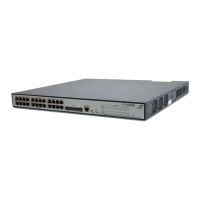214
Field/button Descri
tion
State
Active state of the port. If a port is selected, its state is active and the ID of the
aggregation group it belongs to will be displayed.
Inactive Reason
Reason code indicating why a port is inactive (that is, unselected) for
receiving/transmitting user data. For the meanings of the reason codes, see the
bottom of the page shown in a.
Partner Port Name of the peer port.
Partner Port State
State information of the peer port, represented by letters A through H.
A indicates that LACP is enabled.
B indicates that LACP short timeout has occurred. If B does not appear, it
indicates that LACP long timeout has occurred.
C indicates that the link is considered as aggregatable by the sending
system.
D indicates that the link is considered as synchronized by the sending system.
E indicates that the sending system considers that collection of incoming
frames is enabled on the link.
F indicates that the sending system considers that distribution of outgoing
frames is enabled on the link.
G indicates that the receive state machine of the sending system is using the
default operational partner information.
H indicates that the receive state machine of the sending system is in the
expired state.
Oper Key Operational key of the local port
3 describes the fields in the Partner Port Details table
3. Fields in the Partner Port Details table
Field Descri
tion
Unit Number of the remote system
Port Name of the remote port
Partner ID LACP priority and MAC address of the remote system
Partner Port Priority LACP priority of the remote port
Partner Oper Key Operational key of the remote port.
Return to Dynamic aggregation group configuration task list.
Link aggregation and LACP configuration example
Network requirements
As shown in a, Switch A and Switch B are connected to each other through their Layer 2 Ethernet ports
GigabitEthernet 1/0/1 through GigabitEthernet 1/0/3.
Aggregate the ports on each device to form a link aggregation group, thus balancing incoming/outgoing
traffic across the member ports.

